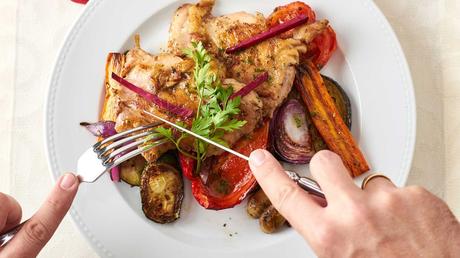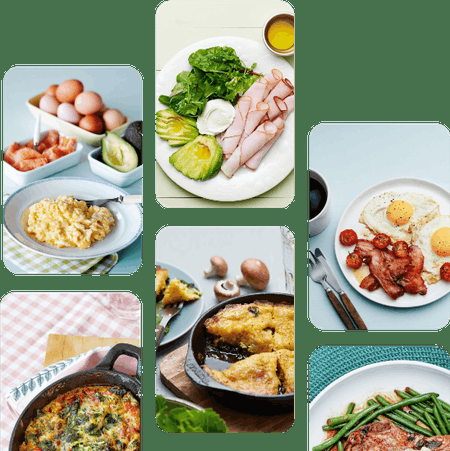If you're ready to try a high-protein diet, it's easy to get started.
And, even if you might not want or need to dramatically increase your protein intake, just about everyone can benefit from prioritizing this important nutrient. This guide will help you do that.
How do you start? On the most basic level, you'll want to increase protein-rich foods and eat less of everything else.
You can make this happen by adding protein foods and subtracting sides (and treats) high in carbs or fat. And you can do it by swapping in a higher protein version of what you were eating before - such as switching from a fatty ribeye to a leaner sirloin.
You can squeeze more protein into your diet at any (or every) meal - breakfast, lunch, and dinner. Snacks and dessert, too.
You can increase protein gradually and see how you feel. Or, you can jump in with both feet and double your protein intake overnight.
There isn't one right way to get more protein. Choose from the options below, and eat your way toward the higher protein targets at your own pace.

Start your FREE 30-day trial!
Get instant access to healthy low-carb and keto meal plans, fast and easy recipes, weight loss advice from medical experts, and so much more. A healthier life starts now with your free trial!
1. Eat more high-protein foods
Wondering how to add more protein to your diet? We can help. Here, we discuss smart ways to up your protein intake at every meal of the day.
Add protein to your breakfast
For many, breakfast is the meal with the least amount of protein. Flip the script on breakfast by aiming for a protein-rich meal. That means eating at least 25 grams of protein for most women and 30 grams for most men.
Studies show that starting your day with a high-protein breakfast sets you up for more fullness and lower energy intake during the remainder of your day.
How can you add protein to your breakfast? It's easy - any high-protein food will do.
Eggs are the most obvious choice. You can fix them in so many different ways. But think big. To get above 25 grams of protein, you'll need to eat four eggs. (For men, to get above 30 grams, you'll need five eggs. 😳)
If that sounds like too much of a good thing, why not pair three eggs with cheese or sausage?
You can enjoy breakfast sausage and savory meats like ham on their own or with cheese, sliced tomatoes, and cucumbers.
Don't forget fish! Smoked salmon is a breakfast classic. Serve it with eggs or layered on top of low-carb crackers. Tuna salad, served with fresh sides like sliced tomatoes or watermelon, can be a perfect budget choice.
Greek yogurt is the creamiest breakfast option. It packs more protein than regular yogurt and comes in single-serve packs for grab-and-go convenience. Check the package, but you'll want at least a cup to get over 25 grams of protein. (You'll need 1¼ cups or more for the guys' higher targets.)
Start with plain Greek yogurt (or even higher protein Icelandic skyr). That way, you can control the amount of sugar or sweetener you add. Go with full fat for a more filling breakfast. Choose low fat or nonfat if you want more protein with fewer calories. Either way, it's delicious with a splash of vanilla extract or topped with berries.
Remember, your breakfast doesn't have to be made up of "breakfast food," so suit yourself and get creative. A crisp bell pepper stuffed with chilled chicken curry might hit the spot. Why not?
Best of all, leftovers from dinner often pack in plenty of protein, and they're right there waiting for you. Dig in.
A protein smoothie is also an option. See more on this below.
Increase protein portions at meals
A simple way to get more protein is to increase the portion size of the protein food that you put on your plate.
Remember, if you're an average-sized woman eating three meals a day, you'll want to include 30 to 40 grams of protein in each meal. If you're an average-sized man, you'll want to have 35 to 50 grams per meal.
(If you routinely skip breakfast, you'll need at least 50 grams per meal for women and 60 grams per meal for men from both lunch and dinner.)
We frequently hear that our readers struggle to eat 30 or 35 grams of protein at breakfast. That's OK! Do your best to get 25 or 30 grams and you can make up for it in your other meals or snacks.
What does it take to get that much protein? It depends upon what you're eating.
Protein serving size per meal
If you don't have a scale to weigh your protein, you can estimate how much you're eating by comparing your portion to the size of a deck of cards, which is roughly 3.5 ounces. For many protein sources, you'll need a portion size closer to two decks of cards to get to your target.
Likewise, if you don't want to measure tofu or beans, remember a cup is about the size of an average fist.
Make room on your plate for this extra protein food by reducing calorie-dense sides, especially starchy ones like rice, bread, or potatoes. You can switch to non-starchy vegetables that help to fill you up but come with fewer calories.
If you already eat low-carb, cut back on the amount of added fats like butter or oil.
For even more ideas about high-protein food, check out our guide, The best high-protein food for weight loss.
Add high-protein garnishes to salads and vegetables
You don't have to get all of your protein from your main course. Top salads and cooked vegetables with these yummy toppings, and you'll sneak in protein while getting your veggies.
Choose high-protein recipes
Want a high-protein meal without getting out your calculator? That's totally doable. Just select a recipe from our high-protein offerings. These meals and main courses serve up at least 30 grams of protein. And at least 30% of their calories come from protein, too.
For more curated browsing, we have a recipe collection highlighting our best high-protein recipes.
Eat high-protein snacks
If you're hungry between meals, a protein-rich snack will fill you up. Reach for these easy favorites for about 10 grams of protein.
- Canned fish (2 ounces)
- Zero-sugar jerky (⅔ ounce)
- Deli meat (2 ounces)
- Hard-boiled eggs (two eggs)
- Cheese (about 1¾ ounces)
- Tofu (about 4 ounces)
- Dry-roasted edamame (3 tablespoons)
For a complete rundown of snacks to try, check out our guide, 21 high-protein snacks, ranked.
Switch to protein-rich desserts
Protein for dessert? You bet. Protein-rich ingredients like eggs, tofu, and Greek yogurt are the secret.
If you're in the mood to bake, try a low-carb soufflé, meringue, or mousse. Or sample our amazing peanut butter brownies.
For dessert simplicity, serve up some Greek yogurt and top with berries. In addition to protein, it delivers on three of our favorite things: it's fast, easy, and creamy.
Drink protein shakes
Is it OK to drink your protein? Sure, in certain circumstances. Protein shakes are an inexpensive, convenient, and tasty way to get your protein. Stirring collagen protein into coffee is a popular option, too.
Some of the flavors sound amazing. Like Banana Cream Pie, Creamy Red Velvet Cake, and Gourmet Cookies and Cream. Yum.
Some evidence suggests that this is a reasonable way to consume some of your protein.
Plant-based protein powders are especially helpful for boosting protein levels in vegan diets.
But these powders are highly processed. For this reason, we recommend favoring whole food sources for most of your protein needs.
Bottom line? Enjoy protein shakes, but use them in moderation. Protein shakes are most beneficial if you struggle to meet your protein goals with whole foods.
2. How much protein do I need?
Your exact protein needs are determined by height and gender and are influenced by goals and activity levels, too.
To get an idea of roughly how much protein you should target each day for your high-protein diet, check out the table below.
High-protein diet minimum daily targets
Aim for approximately this much protein every day.
These targets are approximate and represent the low end of the high-protein range.
You can always go higher (or a little lower) if you find that it's sustainable and you like how you feel.
For a complete discussion of protein levels, please check out our guide, High-protein diet: What it is and how to do it.
Is it necessary to measure and track your food intake to eat high protein? No, it isn't. But it can be useful to track for a short while to make sure you're hitting your protein targets.
Can you overeat protein? If you're healthy, it's hard to do. As long as you stay under 70% of energy from protein, you shouldn't experience harmful side effects. That's a lot of protein: about 350 grams in a 2,000 calorie diet.
(If you have advanced kidney disease or other serious health issues, please follow the diet your physician recommends.)
3. Visualize your protein target
When targeting higher protein levels, it helps to visualize what your plates might look like. If you're like most people, the protein portions will be larger than you're used to.
For women:
Here are three sample plates, each with 30 to 40 grams of protein. Together these deliver about 100 grams of protein. That's the lower end of the range for an average-sized woman who is eating a high-protein diet.
If you're taller than 5 foot 7 inches (170 cm), add even more protein foods to hit your higher target.
For vegetarians, here are three sample plates that will also get you over your 100-gram protein target:
For men:
Men need more protein and should aim for 35 to 50 grams in each meal. Together, these plates deliver over 120 grams of protein, the low end of the range for an average-sized man eating a high-protein diet.
If you're taller than 5 foot 10 inches (178 cm), you'll need to increase portions to hit your higher target.
Interested in plates without meat? No problem. Here are three vegetarian plates that will get you over 120 grams:
Meal plans designed for results
With our personalized meal plans, we do the planning for you. All you have to focus on is cooking, eating, and enjoying healthy, delicious food.

4. Summary
Eating more protein can be a game-changer for weight loss and metabolic health. We hope this guide gets you started.
For more on why a high-protein diet might be right for you, please check out these links:

